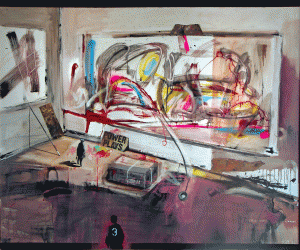« Reviews
Marcus Antonius Jansen: Zeitgeist

Marcus Antonius Jansen, The Apprentice, 2009, oil enamel collage on canvas, 60” x 72”. Courtesy of the artist and 101/exhibit.
101/exhibit - Miami
By Janet Batet
Marcus Antonius Jansen is an urban artist. Chronicler of the metropolitan lifestyle and its surroundings, Jansen is interested in exploring the contemporary human condition trapped in the knotty system of the city. “Zeitgeist,” his exhibition at the 101/exhibit gallery, is a vast survey on the latest production of the artist.
Jansen’s childhood was spent in the midst of the emerging graffiti movement that starred the Bronx in the 1970s. Later, his parents decided to move back to Germany, where the strong expressionist tradition and his extensive traveling definitely influenced the artist. His vivential experiences in neuralgic urban centers and his enrollment in the army in the 1990s were two crucial factors for the understanding of the complicated urban network in the era of the post-industrial society and the transnational corporate world.
Jansen’s oeuvre is a sort of urban legend: mystery and foreboding at the same time that the viewer is compelled to decipher. At first glance, his work seems charged with a surreal urban-like atmosphere, where the conscious and unconscious coexist in a commentary of our everyday world. In fact, the artist faces the creative act as a free flow from the unconscious, without prior sketching or references. This technique allows him to recreate a very particular universe where the most dissimilar icons amalgamate into a superlative palimpsest expression of the interdependent world in which we cohabit.
These frightening and enigmatic suburban cityscapes reveal receding farms, residencies in foreclosure, scattered debris of industry, inhabited by the most capricious creatures: tire-horned goats, flying targeted pigs, silhouetted crows on wires, lonely clowns. Jansen’s characters are victims of oblivion, populating a sort of Limbo, symbol of their pariah status. Alongside these creatures, anodyne signs proliferate: eclipsed suns, abandoned colorful toy balls, tires, fences, supermarket carts, boarded up windows; all of them waste and trail of the urban life. The historic and literal symbols are another imperative key of this disturbing but captivating universe. In this sense, Jansen highlights the allusions to the Weimar Republic as a parallel to our contemporary society, the conjunction of the Titanic and Noah’s Ark in a completely new allegory, or the recurring references to the Wizard of Oz, one of the most widely known American popular culture icons.
Jansen’s artwork is autobiographic in a certain way, and some characters may be identified as the artist itself. Such is the case of the Tin Man, and the errant figure of the artist carrying with his portfolio as the only baggage.
Formally, his work is the result of multiple crossings between historic expressionism, abstract expressionism, graffiti, and pop. With very aggressive and spontaneous brush strokes, Jansen’s mixed media canvasses highlights by the magisterial use of twisted forms, emotional color, and the insertion clips from newspapers, digital prints, or stencils that the artist juxtaposes in a commentary of the global village.
Considered the father of “Modern Urban-Expressionism”, Marcus Jansen entitled his first art book after this movement, characterized by a rebellious response to the rising political and social changes in the postindustrial society.
(May 8 - June 8, 2010)
Janet Batet is an independent curator, art critic and essayist based in Miami, FL.
Filed Under: Reviews


































